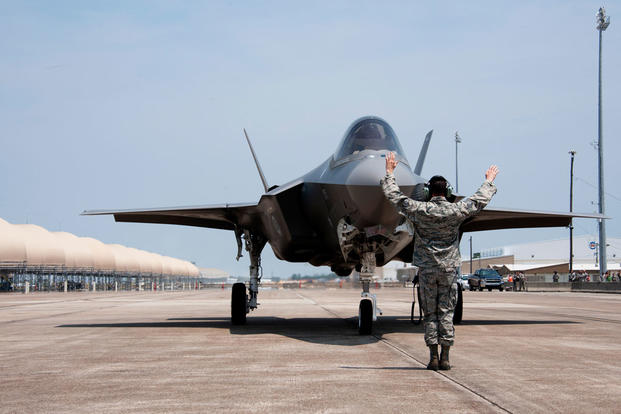SALON DU BOURGET, France -- Local commanders will have to scramble to make up pilot training opportunities as F-35A Joint Strike Fighters attached to Luke Air Force Base, Arizona, remain grounded while officials investigate a recent spike in hypoxia-like incidents.
The grounding, which was announced June 9, is in its 10th day as Air Force brass appear no closer to knowing why the hypoxia-like episodes are occurring in numbers at just one base that flies the F-35. Meanwhile, the operational pause does not come without a cost.
Six young air officers are currently at Luke to complete the F-35 "B-Course," a basic flight training for the platform. Their graduation is scheduled for August.
"We don't have a lot of excess capacity in our training; we are maximizing every single taxpayer dollar we have," Col. Todd Canterbury, chief of the F-35 Integration Office Operations Division, told reporters during a briefing here at the Paris Air Show on Monday. "So this will have an impact."
Related content:
- See Military.com's full coverage of the Paris Air Show
- Air Force: No Clear Cause for F-35A Hypoxia-Related Problem
- The Navy Is Issuing Every F/A-18 Pilot a Garmin Watch. Here's Why
However, Canterbury said, officials in charge of training can take up the slack with more creative and efficient techniques.
"Local commanders will have flexibility with sorties," he said. "I've been a formal training unit wing commander as well as a formal training unit squadron commander, and any delay we're frustrated by, but you can get more efficiency out of sorties ... we don't think this weeklong [pause] will have any major impact on pilot [training] in the future."
A post shared by Military.com (@militarydotcom) on Jun 19, 2017 at 6:56am PDT
That, of course, assumes that Luke gets the green light soon to fly the 48 aircraft affected by the current stand-down. That decision has been left to the commander of the local 56th Fighter Wing, Brig. Gen. Brook Leonard.
Canterbury suggested that fast answers won't be forthcoming about the hypoxia-like episodes that appear to be localized to just one base, but said the goal is to put in place measures to raise pilots' confidence to acceptable levels to fly.
"If [Leonard] senses our pilots are confident and ready to fly, he will return them to fly and they'll start going," Canterbury said.
Several measures the Air Force is considering to improve safety in flight are artificial altitude restrictions on the Luke-based aircraft, since the incidents tend to happen at similar altitudes, and pulse oximeters that pilots can wear on fingertips or earlobes that can accurately show the body's oxygen levels.
"If the jet says I don't have enough oxygen, but their breather, pulse oximeter, says that I'm good to go, that will build confidence," Canterbury said.
He said Air Force officials still hope to see the flight stand-down lifted early this week.
Meanwhile, investigations into the actual cause of the localized cockpit episodes are narrowing the possibilities. Canterbury said investigators have ruled out a specific production lot, since Luke's F-35 contingent includes an array of different lots.
Officials are still looking into whether specific maintenance practices could be a culprit, or whether a specific software system is to blame, looking as far as the software working with the aircraft oxygen controllers.
"That's the granularity that they're really drilling down with to find a root cause," he said. "But it's simply too early to identify."
-- Hope Hodge Seck can be reached at hope.seck@military.com. Follow her on Twitter at@HopeSeck.
Related Video:






























